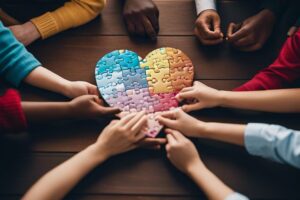Autism Spectrum: Unraveling the Concept of a Spectrum and its Individualistic Nature
The autism spectrum is a broad range of conditions characterized by challenges with social skills, repetitive behaviors, speech, and nonverbal communication. This article aims to clarify the concept of a spectrum and explain how autism can look different in every individual.
Understanding the Spectrum
To appreciate the spectrum aspect of Autism Spectrum Disorder (ASD), think of autism as a rainbow. Each color in the rainbow represents different intensities and combinations of symptoms that people with ASD may exhibit1. Just as no two rainbows are the same, autism manifests uniquely in each individual.
| Color | Symptom Intensity |
|---|---|
| Red | Severe |
| Orange | Moderate |
| Yellow | Mild |
The Individualistic Nature of Autism
Autism is incredibly diverse, and its effects vary from one person to another. Some individuals may require substantial support in their daily lives, while others may need less support and, in some cases, live entirely independently2.
Individuals with autism also differ in:
- Communication abilities
- Intellectual functioning
- Motor coordination
- Attention span
- Physical health conditions, such as sleep disturbances, gastrointestinal disorders, and seizures
The myriad combinations of these characteristics result in a complex condition that affects individuals differently.
High-Functioning Autism and Asperger’s Syndrome
With the release of the Diagnostic and Statistical Manual of Mental Disorders, Fifth Edition (DSM-5), all subcategories of autism, including high-functioning autism and Asperger’s Syndrome, were collapsed into one umbrella diagnosis of Autism Spectrum Disorder3.
High-Functioning Autism
High-functioning autism refers to people with autism who have IQs of 70 or above—essentially, those who are not intellectually disabled. These individuals typically have a strong vocabulary and can articulate their thoughts well but may struggle with social interactions and exhibit other classic signs of autism4.
Asperger’s Syndrome
Asperger’s Syndrome, named after the Austrian pediatrician Hans Asperger, is typically distinguished by a lack of language and cognitive development delays. However, people with Asperger’s often have difficulties with social interactions and exhibit restricted and repetitive behaviors, interests, or activities5.
Although the DSM-5 now groups these conditions under a single diagnosis of ASD, many people still identify with the terms high-functioning autism and Asperger’s syndrome. These labels can provide a sense of identity and community and help individuals understand and communicate their experiences.
Recognizing and Respecting Diversity on the Autism Spectrum
Given the wide range of symptoms and abilities of people on the autism spectrum, it is essential to respect the individuality of each person with ASD.
Here are a few tips to remember:
Autism is not a linear scale: It’s not a matter of “mild” or “severe” autism. Each individual has their unique set of strengths and challenges.
Never assume anything about a person with autism: Always ask about their experiences and preferences.
Inclusion is crucial: Inclusion and acceptance foster a sense of belonging, which is essential for everyone, including those on the autism spectrum.
It’s also important to remember that with the right support, people on the autism spectrum can lead fulfilling lives. Different therapies, such as speech and language therapy, occupational therapy, and applied behavior analysis (ABA), can help individuals with autism enhance their abilities and minimize their challenges6.
Understanding the unique and diverse nature of autism is the first step towards building a more inclusive society. It’s a journey of learning, acceptance, and celebration of diversity.
Remember, every individual with autism has their unique story. Just as a rainbow isn’t defined by a single color, the autism spectrum isn’t defined by a single characteristic. Each person on the spectrum adds a unique color to the autism rainbow.
Footnotes
American Psychiatric Association. (2013). Diagnostic and statistical manual of mental disorders (5th ed.). https://doi.org/10.1176/appi.books.9780890425596 ↩
Autism Society. (n.d.). What is Autism? https://www.autism-society.org/what-is/ ↩
American Psychiatric Association. (2013). Diagnostic and statistical manual of mental disorders (5th ed.). https://doi.org/10.1176/appi.books.9780890425596 ↩
Mandy, W., & Lai, M. C. (2017). Annual research review: The role of the environment in the developmental psychopathology of autism spectrum condition. Journal of Child Psychology and Psychiatry, 58(3), 271–292. https://doi.org/10.1111/jcpp.12652 ↩
Attwood, T. (2007). The complete guide to Asperger’s syndrome. Jessica Kingsley Publishers. https://www.jkp.com/usa/the-complete-guide-to-asperger-s-syndrome-2.html ↩
National Institute of Mental Health. (n.d.). Autism Spectrum Disorder. https://www.nimh.nih.gov/health/topics/autism-spectrum-disorders-asd ↩







